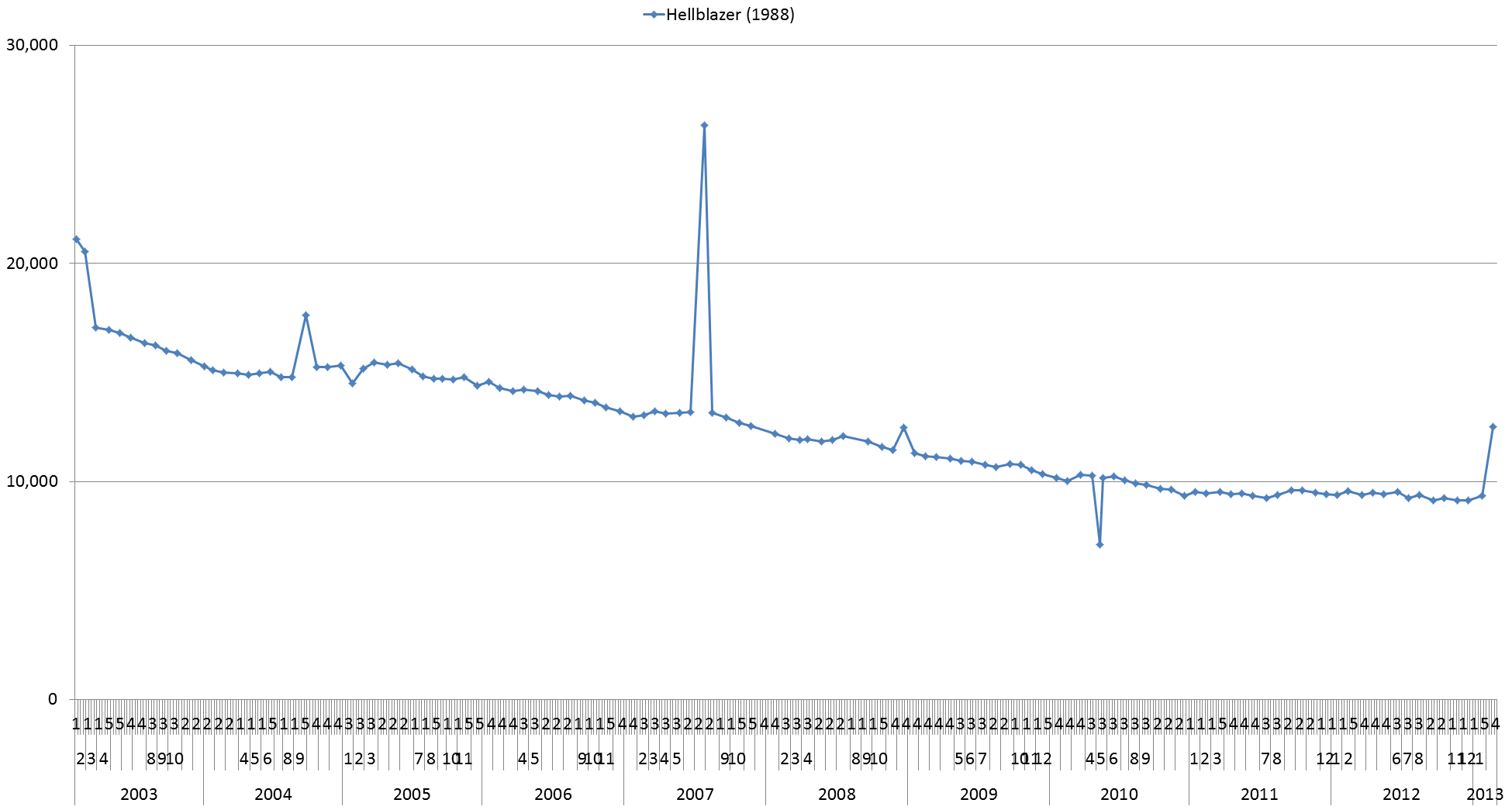Mayo Report for 2013-02

|

|
Top Comics List Top Comics Breakdown Top Trades List Top Trades Breakdown
With multiple titles launching as part of the Marvel Now initiative at Marvel, it is no surprise that Marvel had the most sales in the top 300 comics for February 2013 with around 41.89% of the total unit sales. DC accounted for 34.92% of the total units with the other premiere publishers (Dark Horse, IDW and Image) taking another 16.08%. Dynamite Entertainment, Boom! Studios and Valiant had a combined 4.60% of the sales and the remaining 2.51% of the top comics sales were split across a few other publishers from the back half of Previews.
Topping the list by a wide margin was "Justice League of America" #1 with 307,734 estimated units thanks to the 52 independently orderable alternate covers in addition to the standard cover. DC has stated they will be cutting back on variant covers going forward. This particular cover stunt had to be very profitable for DC on this first issue. The second issue drop on this will be huge, probably in the ballpark of 60% to 70%. While I think these sorts of marketing stunts prey on the collector/speculator market and can be harmful to the long term health of the industry, I completely understand why the publishers do them. This title probably would have broken the 100,000 mark without the marketing stunt. With it, DC was able to bump the sales of the first issue to two or three times for the cost of replacing the flag portion of the image. Essentially, DC took the easy route to success with this title.
The previous volume of "Justice League of America" was another high profile launch and had some sales bumps on early issues due to variant cover gimmicks. Once Brad Meltzer left the title, the sales started as fairly steady decline. The late Dwayne McDuffie did a great job on the title from late 2007 to the middle of 2008 when Len Wein took over few a few issues. James Robinson took over the title with issue "Justice League of America" #38 in October 2009 featuring characters like Donna Troy, Mon-El, Starfire, Congorilla and Starfire. That new line up of characters caused a bump in sales initially but the shiny newest quickly wore off. The volume finished prior to the New 52 reboot with sales around 55,000 units.
With the New 52 reboot came the current "Justice League" series by Geoff Johns and Jim Lee with initial sales around the quarter million mark on the first issue. The later issues sold less but the series has yet to dip below 100,000 units but could do so at any time.
"Justice League of America's Vibe" #1 sold around 27,051 units. Given the history of the character, that level of sales isn't surprising. The original version of Vibe was a blatant stereotype based on a cultural aspect that seems very dated to today's readers. The odds of this title ever selling above 30,000 units are low given that most titles drop in sales after the first issue. It is much more likely the title will fall into the danger zone of sales under 20,000 units. This is a title that would have benefited from a marketing stunt that got readers to try it out. Many DC fans were going to check out "Justice League of America" #1 while the majority of DC fans were probably not even considering getting "Justice League of America's Vibe" #1. The extra copies of "Justice League of America" #1 sold as a result of the 52 variant covers could easy exceed the total sales of the entire run of "Justice League of America's Vibe" depending how long the title lasts.
It comes down to what the goal of comic book marketing departments really is. Is the goal to boost sales as much as possible each month or is the goal to boost readership as much as possible? Sales bumps can be done using cover gimmicks, crossovers, events and other such tactics which can be very successful. But those sales last only as long as the gimmick. Rarely do the sales carry over to the subsequent issues. One of the favored marketing tactics at Marvel these days is relaunching a title with a new first issue. While that bumps the sales of the first issues, "Uncanny X-Men" #2, "Savage Wolverine" #2, "Uncanny X-Force" #2, "Young Avengers" #2 and Morbius, the Living Vampire" #2 averaged a 40.85% drop losing a total of 202,402 from the respective first issues. Clearly the tactics resulted in increased sales but not increased readership.
Often, titles that tend to attract and keep a loyal readership are creator owned properties. This has little to do with the legal ownership of the property and everything to do with the clear creative vision of these creators on these properties. For example, the sales of "Morning Glories" by Nick Spenser and Joe Eisma are reasonably stable. Sure, the sales are drifting downwards over time but minimally.
Another example of a title with a clear creative vision that isn't creator owned is "X-Factor" by Peter David. Aside from the bump in the middle of 2010 caused by the Second Coming storyline which went through the various X-Men titles, the title has been relying on the merits of the stories and not leveraging every event in the Marvel Universe over the past few years. Again, the sales trend isn't a perfectly flat line but it is very predictable and reliable. Readers want stories that aren't predictable but retailers want sales that are predictable. Predictable stories and unpredictable sales are bad for both the titles and the retailers.
The advantage of building up a readership is stable and reliable sales. Based on the current sales levels, the next round of cuts from DC will probably be "Batwing," "Dial H," "Demon Knights" and "Stormwatch." "Stormwatch" seems to be getting cross promoted in other titles like All-Star Western so Dc might be trying to keep that title around. "Legion of Super-Heroes" #17 sold approximately 16,242 units putting it squarely in the danger zone. With "Legion Lost" ending, "Legion of Super-Heroes" becomes a fairly self-contained title which might buy it a little time to see if it gains sales as a result of "Legion Lost" ending.
The top seller from the back half of Previews was "Legend of the Shadowclan" #1 from Aspen with an estimated 33,246 units. This issue was part of the 10 for $10 that Aspen is doing this year. This sort of promotion lets readers try out the title with less risk and can bring in readers that would have otherwise passed on the title. Often the second issue drops on this seem harsh if you look at it from the units perspective but minimal if you look at it from the dollars perspective. This was the only item in the top 300 comics from Aspen in February.
Promotional pricing on introductory issues can be a very effective way to market a title. In the case of "Deathmatch," the second issue dropped by nearly 74% but brought in around 4.45% more dollars than the first issue. This is a long term strategy as the publisher is betting on the quality of the title and readers who try it will come back for more. The 30.32% drop on the third issue is not a good sign, particularly with sales dropping to around 6,490 units.
The Valiant titles continue to cluster between around 11,500 and 14,700 units. Both Dark Horse and Image had better average sales than Valiant in February. Within the top 300, Valiant is only about 4,000 units shy of the total sales of Boom! Studios. I'm keeping a close eye on Valiant because it is one of the few publishers to come along in a while that looks like it could compete at the same level as Dynamite Entertainment and Boom! Studios.
Down near the bottom of the list is "High Ways" #2 from IDW with an estimated 4,204 units. This is a science fiction miniseries by John Byrne focus on the crew of a cargo spaceship. It dropped 34.84% from the first issue. IDW did a fine job promoting it and it seems like it might appeal to readers of some of the other titles at IDW like the Star Trek titles. It is a creator owned property by a well-known creator yet it barely made it into the top 300.
"Hellblazer" #300 sold an estimated 12,522 units. That issue marked the end of the 25 year run of the title and the Vertigo corner of the DC Universe. Here is a chart of the sales of the title during the final order era that started in early 2003 when Diamond first started reporting what was invoiced to retailers instead of pre-order information. The spike on the issue in 2007 was "Hellblazer" #234 which was originally printed with a page missing dialogue. The following month, a corrected version was released and both versions appeared in the data from Diamond as sales which effectively doubled the numbers for that issue. As for the bump at the end, some readers are curious how things end for a character and/or title. I'll admit to being one of those people on this title.
As for if February 2013 was a good month or not, that depends on your perspective. The unit sales for the top 300 comics totaled to an estimated 7,007,580 units. That is up around 288,674 units from January 2013. However, if comparing each item on the list to the previous issue of the same title results in sales being down around 505,172 units. From one angle, it was a good month, from another angle, not so much. Take your pick as to which metric, if either, is important to you.







